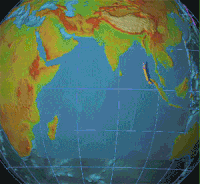
Photo from wikipedia
The active sources generate seismic waves transmitting through the deep underground and can be used to image high-resolution subsurface structures. Therefore, an appropriate seismic source is the key factor to… Click to show full abstract
The active sources generate seismic waves transmitting through the deep underground and can be used to image high-resolution subsurface structures. Therefore, an appropriate seismic source is the key factor to active source exploration. In order to study the structure of continental crust and its temporal variations, we selected an artificial seismic source generated from releasing air bubbles in water (airgun source hereinafter) out of a variety of artificial sources like the explosion, electronic sparkers, hammering, eccentric vibration, heavy-duty train vibration, and vibroseis etc. Airgun source is a new type of artificial source that have been proven to be environmentally friendly, safe, and highly efficient. Three Fixed Airgun Signal Transmission Stations (FASTS) have been built a few years ago in Yunnan, Xinjiang, and Gansu provinces in western China and have been continuously running for several years. Seismic waves generated by the airgun sources are highly reproducible and stacking of them can produce good seismograms on stations far away from the source, for instance, seismic waves produced in Xinjiang FASTS can be well recorded nearly 1300 km away after 5000 stacking, covering an area of 6 million km2 and penetrating down to a depth of about 60 km. Establishing about 10 FASTSs in China would enable long-term continuous underground monitoring of all 9.6 million km2 of land area. Treating airgun active sources as lanterns to illuminate subsurface structures, we can achieve the situation with “Beidou surveys from the sky and lantern illuminates underground”.
Journal Title: Science China Earth Sciences
Year Published: 2017
Link to full text (if available)
Share on Social Media: Sign Up to like & get
recommendations!